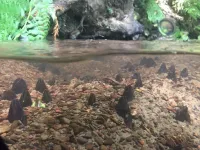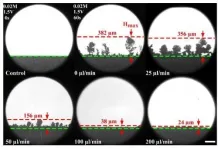(Press-News.org) Pesticides used in forestry may threaten species in downstream rivers and estuaries, but little is known about the extent to which this occurs. A new study by researchers at Portland State University found mussels, clams and oysters in watersheds along the Oregon Coast are exposed to pesticides used in managing forests. The results of this study, published in the journal Toxics, have implications for developing better forest management practices that are less likely to negatively affect aquatic life.
The study was led by Kaegan Scully-Engelmeyer, PhD student in the Earth, Environment and Society program at Portland State University, and Elise Granek, professor of Environmental Science and Management at Portland State University. Max Nielsen-Pincus, also faculty in Environmental Science and Management at Portland State University, and researchers at the Oregon Department of Land Conservation and Development, the Oregon Department of Fish and Wildlife, the U.S. Geological Survey and the Oregon Department of Environmental Quality also contributed to the study.
To explore how forest management practices affect downstream coastal ecosystems, Scully-Engelmeyer and Granek collected samples of three species of aquatic bivalves--the Western pearlshell mussel, softshell clam and Pacific oyster--at eight watersheds along the Oregon Coast. These organisms are good indicators of environmental contamination because they are sedentary filter feeders.
The researchers also used special membranes to passively collect pesticides in the water at 15 watershed sites over a span of 45 days.
"During a rainfall event, you have pulses of pesticides washed from the land that move through the water," Scully-Engelmeyer said. "Passive water samplers are a way to monitor for these types of exposure."
The researchers tested both the bivalve tissue samples and the filtered water samples for the presence of dozens of different pesticides, including herbicides, fungicides and insecticides. They detected 16 different compounds in bivalve and passive water samples, five of which are currently used in forestland management. They also collected data from the state's public notification system, which reports pesticides used in state-regulated forestlands, to see if there were relationships between these notifications and the presence of different pesticides.
"The system provides notified activities so you don't know with 100% accuracy which chemicals were used and at what date," Scully-Engelmeyer said. "We can't say it's directly related to these specific activities, but we did find that it's related to notified activity upstream."
The team found pesticides in 38% of the bivalve samples, showing that compounds used on land were present at sufficient enough levels to accumulate in the tissues of mussels, clams and oysters. Indaziflam, an herbicide currently used in Oregon forestry, was found in 7% of the bivalve samples. Contaminants also included pesticides used in orchards, Christmas tree farms, and homes as well as previously used -- and now banned -- pesticides, including DDT byproducts.
The types and amounts of pesticides varied by site, but all watersheds had at least one of the 12 chemicals detected in sampled bivalves. The most contaminated organisms were collected along the Central Oregon Coast, in the Siuslaw and Smith watersheds.
"The levels of the particular compounds we detected are not something that federal guidelines consider harmful to human health, however, they may be harmful to animals in aquatic and marine environments," Granek said. "Additionally, we were just looking at a handful of compounds, yet aquatic organisms and their consumers are likely exposed to many more contaminants including microplastics and heavy metals, among others. How the exposure we detected -- paired with other contaminants they may encounter in their waters -- affect the animals sampled or their predators is a really interesting question and unfortunately we don't have regulatory guidelines that consider exposure to multiple stressors."
The results of this study -- and subsequent studies -- may help guide evidence-based forest management practices to reduce the amounts of forestry chemicals entering aquatic ecosystems.
Forestry management has long been a contentious issue in Oregon with the timber industry and environmental groups frequently struggling to find common ground, however there are signs this is changing:
-In June, Senate Bill 1602, which changes some of Oregon's non-federal forestland protections, including the size of helicopter pesticide spray buffers along streams, passed almost unanimously.
-And last February, Governor Kate Brown announced the Private Forest Accord, an agreement that 13 timber and forest products entities and 13 environmental organizations will work together to determine recommendations for changing how forests are managed.
Granek has been contacted by this working group about the study. "This work is really timely," she said. "I hope it will inform some of their process."
Granek and others in her lab are currently studying how individual pesticide compounds -- and combinations of these compounds -- affect the health, growth and survival of softshell clams. She hopes results of this work will also be shared with the Private Forest Accord working group.
INFORMATION:
The coronavirus pandemic has drawn new attention to the digital divide, as the need for online schooling and working from home has disproportionately hurt those without computer equipment and skills.
Research by Paul A. Pavlou, dean of the C. T. Bauer College of Business at the University of Houston, found that people with basic Information Technology (IT) skills - including the ability to use email, copy and paste files and work with an Excel spreadsheet - are more likely to be employed, even in jobs that aren't explicitly tied to those skills.
People with more advanced IT skills generally earned higher salaries, the researchers found. The work is described in Information Systems Research.
"Unemployment and low wages remain pressing societal challenges in the wake of increased ...
A new study has shown that gentle streams of water carrying sound and microscopic air bubbles can clean bacteria from salad leaves more effectively than current washing methods used by suppliers and consumers. As well as reducing food poisoning, the findings could reduce food waste and have implications for the growing threat of anti-microbial resistance.
Salad and leafy green vegetables may be contaminated with harmful bacteria during growing, harvesting, preparation and retail leading to outbreaks of food poisoning which may be fatal in vulnerable groups.
Because there is no cooking process to ...
Healthcare sex discrimination protections for the LGBTQ community may be expanded under the Biden Administration, including safeguards against verbal abuse, physical abuse and the denial of bedside care, according to West Virginia University College of Law experts.
In a report published in California Law Review, Professor Valarie Blake and students Ashley Stephens and Amy Post examined whether gender identity and sexual orientation should be included in healthcare sex discrimination laws, on the heels of the historic 2020 Supreme Court case Bostock v. Clayton County.
In that case, the Court ruled that sex discrimination includes gender identity and sexual orientation when it comes to employment standards. Yet the interpretation of whether ...
Scientists at the University of Bath in the UK have found a way to bind together two photons of different colours, paving the way for important advancements in quantum-electrodynamics - the field of science that describes how light and matter interact. In time, the team's findings are likely to impact developments in optical and quantum communication, and precision measurements of frequency, time and distances.
APPLE AND WAVE: THEY BOTH HAVE A MASS
An apple falling from a tree has velocity and mass, which together give it momentum. 'Apple energy' derived from motion depends on the fruit's momentum and mass.
Most people find ...
Volcanic basalt rocks in the Black Rock Desert, Utah.
If you drive south through central Utah on Interstate 15 and look west somewhere around Fillmore, you'll see smooth hills and fields of black rock. The area is, aptly, named the Black Rock Desert. It may not look like much, but you're looking at some of Utah's volcanoes.
A pair of earthquake sequences, in September 2018 and April 2019, focused scientists' attention on the Black Rock Desert. The sequences, which included the main quakes and their aftershocks, were very different from the Magna earthquake that shook the Wasatch Front in 2020 and other Utah earthquakes. The Black Rock sequences were captured ...
Since early in the pandemic, COVID-19 has been associated with heart problems, including reduced ability to pump blood and abnormal heart rhythms. But it's been an open question whether these problems are caused by the virus infecting the heart, or an inflammatory response to viral infection elsewhere in the body. Such details have implications for understanding how best to treat coronavirus infections that affect the heart.
A new study from Washington University School of Medicine in St. Louis provides evidence that COVID-19 patients' heart damage ...
Positive psychological effects associated with taking small doses of psychedelic drugs are likely the result of users' expectations, suggests a study published today in eLife.
The study - the largest placebo-controlled trial on psychedelics to date - used an innovative 'self-blinding citizen science' approach, where members of the public who were already microdosing implemented their own placebo control following online instructions. The results from the trial may influence future studies in real-world settings.
There has been renewed interest in studying whether psychedelic drugs may be a useful treatment for depression, addiction, obsessive-compulsive disorders and other conditions. Few small studies have previously suggested that microdoses ...
A new paper from associate professor Jiandi Wan's group in the UC Davis Department of Chemical Engineering, published in Science Advances, proposes a potential solution to dendrite growth in rechargeable lithium metal batteries. In the paper, Wan's team prove that flowing ions near the cathode can potentially expand the safety and lifespans of these next-generation rechargeable batteries.
Lithium metal batteries use lithium metal as the anode. These batteries have a high charge density and potentially double the energy of conventional lithium ion batteries, but safety is a big concern. When they charge, some ions are reduced to lithium ...
In a new study from Shiley Eye Institute at UC San Diego Health, researchers have identified a potential new marker that shows cardiovascular disease may be present in a patient using an optical coherence tomography (OCT) scan -- a non-invasive diagnostic tool commonly used in ophthalmology and optometry clinics to create images of the retina. The finding suggests it may be possible to detect heart disease during an eye examination.
In the paper published March 2, 2021 in EClinical Medicine by The Lancet, the research team examined lesions of the retina, the inner-most, light-sensitive layer of the eye, to determine if a cardiovascular disorder may be present.
"The eyes are a window into our health, and many diseases can manifest in the eye; cardiovascular ...
NEW YORK, NY--March 2, 2021--In March and April 2020, mental health claim lines for individuals aged 13-18, as a percentage of all medical claim lines, approximately doubled over the same months in the previous year. At the height of the spring wave of the COVID-19 pandemic, this rise in mental health claim lines amounted to 97.0 percent in March and 103.5 percent in April. These are among the many findings in FAIR Health's new white paper, the seventh in its COVID-19 studies, The Impact of COVID-19 on Pediatric Mental Health: A Study of Private Healthcare Claims.
In those same months of March and April 2020, all medical claim lines (including mental health claim lines) decreased by approximately ...







